"That's All She Wrote"
(Favorite saying of Braxton Bragg Comer Wilson)
by
Carolyn Hastings Dickinson

Braxton Bragg Comer Wilson
and Carolyn Hastings.

Foreword
|
Before we can talk about Braxton Bragg Comer Wilson, from this point on to be called B.B., I think it would be interesting to mention those from whom he descended. We do this out of respect and to thank them for paving the way for us to follow.
|
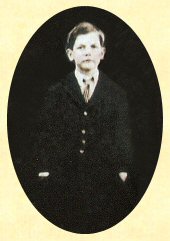
|
Without these brave pioneers, who braved untold hardships in coming to this wild, untamed country in southern Alabama and northern Florida in the nineteenth century, we would not have the colorful and fruitful heritage we are talking about today. We do owe a debt of gratitude to all of our forbearers and by recording their history, we also record our history.
|
B.B. Comer Wilson
Age 8, 1915
Click to enlarge.
|
|
My next question is: how do I tell the history of my grandparents, B.B. and Jennie Philips Wilson, who had such a dramatic impact and influence on my life? I have always called Grandpa, "My Hero", and if he is my hero, then Grandma is my "Angel".
|

|
B.B. Wilson and Carolyn Hastings in 1954. - Click to Enlarge.
|
|
I don't believe any of these humble people realized the influence they would have on so many future generations. My prayer is that we will continue this heritage for even more generations of Wilsons not even thought of yet.
|

At the turn of the nineteenth century, about 1802, a new baby boy, to be named Henry Wilson, was born to unknown parents. Would he grow up to be a military leader, a politician, a farmer, a carpenter, a doctor, or a lawyer? We, his great-great-great-grandchildren can only guess that he was a farmer. This guess is based on the fact that he came to Alabama from North Carolina in circa 1830 with six sons and a wife; name unknown and settled in what is now Conecuh County. These six sons were named Elijah Littleton, born in 1825-1883; Henry H., born in 1830-1908; James, born in 1834; William Henry Harrison, born 1836 and died before 1870 (death in Civil War?); his widow received a pension in Sumter County, Florida; John, born 1837; and Charles, born in 1838.
From census reports we see that Henry must have died before 1850 in Conecuh County, Alabama. This information is gleaned from the 1850 census showing the four youngest sons living with his brother John Wilson and family. Eldest son, Elijah Littleton, with his wife, Elizabeth and his young family are living next door. Second son, Henry H. (or could it be T. for Thorton or Travis) Wilson, then moves further southeast into what is now Escambia County, Florida. He marries and homesteads land; we have a deed for 159.99 acres in July 1896. He is listed as a timber man and railroad laborer. This southern area was well suited for farming, timber, and cattle; therefore pioneers were drawn to it from areas further north. It was advertised that a man could raise a variety of crops year round, cattle could graze almost year round on grasses without having to buy feed and virgin pine timber was ripe for harvest.
Henry H. Wilson married Mary Ellen Vickery on April 14, 1849; the marriage license is recorded in the marriage record book in Escambia County, Florida. Mary Ellen Vickery born to Richard Vickery and Mary Lucinda Entrekin in Escambia County, Alabama. The property they homesteaded was located in Dry Springs, Florida. The deed is recorded in the Escambia County, Florida Courthouse. That original acreage is located across from the present day Dry Springs Baptist Church. They are buried in the church cemetery there, in a wrought iron fence enclosed plot, just the two of them. On the gate is the Wilson name in wrought iron. It is said that Henry's son, John T. Wilson, placed the fence there after Henry died on January 31, 1908 and was interred there. Mary Ellen Vickery Wilson preceded her husband in death on August 5, 1897 in Escambia County, Florida and is also interred there. Henry lived his final days in Blacksher, Alabama in a little wood frame house beside his son, John Travis Wilson's family home. Story has it that Henry had a "tumor" that caused him a great deal of pain, but he refused to be seen by the doctor.
Wilson Family Plot
Dry Springs Baptist Church Cemetery
Escambia County, Florida
Click each photo to enlarge.

Wilson Family Plot.
|

Wilson Family Plot.
|

Henry H. Wilson and Mary Ellen Wilson graves.
|

Mary Ellen Wilson grave.
|

Henry H. Wilson grave.
|
Henry Wilson and Mary Ellen (Vickery) Wilson begat ten children. These included:
- Sara C. Wilson, (Aunt Sally, the family's mid-wife) born 1854-1930;
-
Charles Young Wilson, born 1856-1913;
-
Japeth (Jabe) Richard Wilson, born 1858-1920;
-
William Harrison Jackson Wilson, born 1861-1933;
-
Henry Thorton Wilson, born 1863-1904;
-
John Travis Wilson, was born in 1866 in Daphne, Alabama and died in 1916 in Mobile, Alabama;
-
Obediah (Obe) A. Wilson, born 1868-1941;
-
Robert (Bob) Brewster Wilson, born 1870-1916;
-
Andrew Wiley Wilson, born 1875-1940;
-
Cornelia Lucinda "Onelia" Wilson, born 1877.
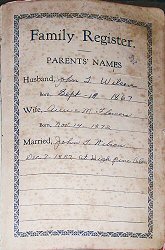 John T. was a very industrious worker and had high ambitions for his life. This is evidenced by his labors in the timber business. He worked hard and saved his money to invest in land across the river in Baldwin County, Alabama; specifically, the Blacksher area. In 1887 he fell in love and married a young lady named Annie Missouri Flowers. The only documented evidence of their marriage is written in Annie's family Bible. It is now in possession of one of her great-grandsons. The entry is dated Dec. 7, 1887, in High Pine, Florida. Annie worked by John's side to accomplish his high ambitions. It is recorded by family historians that John T. would drag the logs out of the swamps by mules teams and Annie would help skin the bark off of them before floating them down the river to the sawmill. All the while, they began what was to become a large family of sixteen children, thirteen surviving to adulthood.
John T. was a very industrious worker and had high ambitions for his life. This is evidenced by his labors in the timber business. He worked hard and saved his money to invest in land across the river in Baldwin County, Alabama; specifically, the Blacksher area. In 1887 he fell in love and married a young lady named Annie Missouri Flowers. The only documented evidence of their marriage is written in Annie's family Bible. It is now in possession of one of her great-grandsons. The entry is dated Dec. 7, 1887, in High Pine, Florida. Annie worked by John's side to accomplish his high ambitions. It is recorded by family historians that John T. would drag the logs out of the swamps by mules teams and Annie would help skin the bark off of them before floating them down the river to the sawmill. All the while, they began what was to become a large family of sixteen children, thirteen surviving to adulthood.
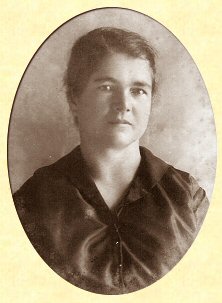
|
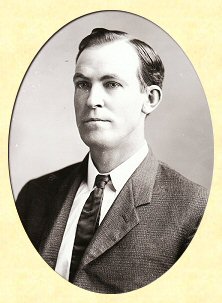
|
Annie Missouri Wilson
about 1900
Click to enlarge.
|
John Travis Wilson
about 1900
Click to enlarge.
|
 Annie Missouri Flowers was born on November 17, 1872 to Wright and Milbrey Pate Flowers in Claiborne, Alabama. The Flowers' ancestors had traveled the trail southward from North Carolina with oxen teams and hogshead. Annie's grandfather, Luke Flowers, was born in 1804 in Columbus, North Carolina to parents, Goldsbrough and Rebecca Wingate Flowers Sr. and died in 1897 in Dry Springs, Escambia County, Florida. He married Doratha Gilpin Risen, born in 1809 in Columbus County, North Carolina and died in 1865 in Pike County, Alabama. The couple originally homesteaded property in Pike County, Alabama in circa 1824 and had a family of eight children. After his wife, Doratha died, he remarried a much younger, forty year old woman, Margarite Mary Smith in 1884 in Coffee County, Alabama and resettled to what is now Escambia County, Florida in the year 1885. He owned a large, prosperous plantation, as well as being a slave owner; not uncommon for that day and time. This was just across the Perdido River from Escambia County, Alabama. Luke is buried, along with his son and daughter-in-law, Wright and Milbrey Flowers, in the High Pine or present-day, Locke Cemetery located in Phillipsville, Alabama. Their descendants remain on the land today. Some are still farming and raising cattle on that original land that has remained in the family since the mid-1800's.
Annie Missouri Flowers was born on November 17, 1872 to Wright and Milbrey Pate Flowers in Claiborne, Alabama. The Flowers' ancestors had traveled the trail southward from North Carolina with oxen teams and hogshead. Annie's grandfather, Luke Flowers, was born in 1804 in Columbus, North Carolina to parents, Goldsbrough and Rebecca Wingate Flowers Sr. and died in 1897 in Dry Springs, Escambia County, Florida. He married Doratha Gilpin Risen, born in 1809 in Columbus County, North Carolina and died in 1865 in Pike County, Alabama. The couple originally homesteaded property in Pike County, Alabama in circa 1824 and had a family of eight children. After his wife, Doratha died, he remarried a much younger, forty year old woman, Margarite Mary Smith in 1884 in Coffee County, Alabama and resettled to what is now Escambia County, Florida in the year 1885. He owned a large, prosperous plantation, as well as being a slave owner; not uncommon for that day and time. This was just across the Perdido River from Escambia County, Alabama. Luke is buried, along with his son and daughter-in-law, Wright and Milbrey Flowers, in the High Pine or present-day, Locke Cemetery located in Phillipsville, Alabama. Their descendants remain on the land today. Some are still farming and raising cattle on that original land that has remained in the family since the mid-1800's.
Locke Cemetery
Phillipsville, Alabama
Click each photo to enlarge.
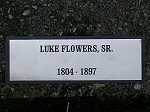
Luke Flowers, Sr.
|
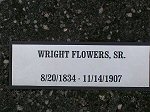
Wright Flowers, Sr.
|
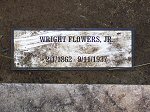
Wright Flowers, Jr.
|
Wright Sr. was born on August 20, 1834 in Pike County, Alabama and died on November 14, 1907 in Phillipsville, Baldwin, County, Alabama. His wife, Milbrey Pate Flowers, was born on February 11, 1839 in Thomas County, Georgia to Samuel and Tassey Pate. Milbrey followed her husband in death on February 1, 1916 in Mobile, Alabama where she had lived out her final days with family.
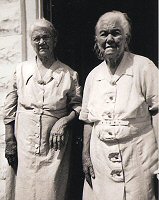
Annie and sister, Levonia Flowers.
|
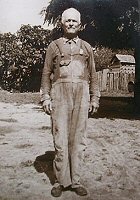
Wright Flowers, Jr.
|
Wright and Milbrey Pate Flowers married about 1856 in Baldwin County, Alabama and had a family of fourteen children. These included:
- Eli Shorter Flowers, born 1858-1938;
-
Lucretia Flowers, born 1859;
-
Orvell Flowers, born 1861-1933;
-
Wright Flowers, Jr., born 1863-1937;
-
Gilpin Flowers, born 1865;
-
Leona Flowers, born 1866-1950;
-
Annie Flowers, born 1872-1957;
-
Samuel Flowers, born, 1874-1952;
-
Sterling Flowers, born 1876-1957;
-
Daisy Flowers, born 1878-1906;
-
Milbrey Flowers, born 1881;
-
Levonia Flowers, born 1883;
-
Amanda Flowers, born 1867-1895;
-
Susan Flowers, born 1870.
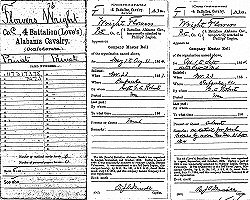 Wright Flowers Sr. served in the Civil War under Captain G. A. Roberts as a Private in the Confederate 4th Alabama Cavalry (Love's) Battalion, Company C. (Card #473173787475) He enlisted November 23, 1863. On a Muster Roll dated April 1 to September 28, 1864, he was listed as absent with the remark: "On detail for fresh horses by orders of General Lee". Milbrey drew a widow's pension of only $24.00 per month.
Wright Flowers Sr. served in the Civil War under Captain G. A. Roberts as a Private in the Confederate 4th Alabama Cavalry (Love's) Battalion, Company C. (Card #473173787475) He enlisted November 23, 1863. On a Muster Roll dated April 1 to September 28, 1864, he was listed as absent with the remark: "On detail for fresh horses by orders of General Lee". Milbrey drew a widow's pension of only $24.00 per month.
Three of the Flowers' daughters married three of the Wilson's sons. John Travis married Annie Missouri, Robert Brewster married Amanda, and Obediah married Susan. These three families all eventually moved across the river to Baldwin County, Alabama. They became successful businessmen in their own right.
John Travis and Robert Brewster Wilson established a turpentine still and Wilson Naval Store Company in Blacksher, Alabama. Obediah was a merchant and owned and operated a general store. A 1905 Business and Community Directory for Baldwin County listed Blacksher with a population of 75 with the Banking Town of Bay Minette. Under businesses is listed O.A. Wilson as GSM (General Store); Obadiah A. "Obe" DOB 8-18-1868. Also listed was Tensaw, Baldwin County with Wilson, J.T. - Turpentine.
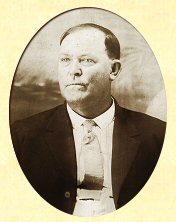 John T. and Robert B. Wilson both died pre-maturely from illnesses in 1916 only seven months apart. John T.'s family of thirteen children remained in Blacksher until 1925-1926 when Annie bought forty acres and built a large home in Silverhill, Alabama. She would eventually sell all of the Blacksher land holdings as well as the business. John T. owned hundreds if not thousands of acres of timber land in the north Baldwin County area from Highway 59 in Blacksher east to Lottie, Alabama. Robert's family remained in the north Baldwin area and both Robert and his wife, Varina, are buried in the little Wilson Family Cemetery located right beside Highway 59 in Blacksher.
John T. and Robert B. Wilson both died pre-maturely from illnesses in 1916 only seven months apart. John T.'s family of thirteen children remained in Blacksher until 1925-1926 when Annie bought forty acres and built a large home in Silverhill, Alabama. She would eventually sell all of the Blacksher land holdings as well as the business. John T. owned hundreds if not thousands of acres of timber land in the north Baldwin County area from Highway 59 in Blacksher east to Lottie, Alabama. Robert's family remained in the north Baldwin area and both Robert and his wife, Varina, are buried in the little Wilson Family Cemetery located right beside Highway 59 in Blacksher.
Wilson Family Cemetery
Blacksher, Baldwin County, Alabama
Click each photo to enlarge.
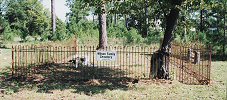
Wilson Family Cemetery in 2007.
|
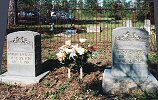
Robert and Varina Wilson Plot.
|
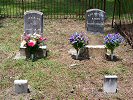
J.T. Wilson Infant's graves.
|
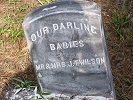
J.T. Wilson Infant's graves.
|

J.T. Wilson Infant's graves.
|
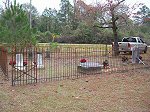
Concrete pedestal left from John T. Wilson's headstone can be seen in the center of the cemetery.
|
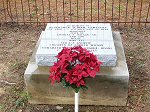
Concrete pedestal left from John T. Wilson's headstone that was moved to the Silverhill Cemetery in circa 1926, after wife Annie and children moved south.
|
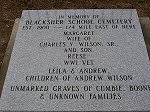
List of known burials at the Blacksher School Cemetery.
|
John T. and Annie Missouri begat sixteen children; including pre-mature twin boys that died within minutes of birth on November 27, 1913. A two week old infant daughter also succumbed to death in circa 1914; these three are buried in the little Wilson Family Cemetery in Blacksher. Also buried there is a twenty-four year old daughter, Hattie Mae Wilson Butler, who died in 1923 from a systemic infection. She had married Willard Butler and they had one son, Willard Butler Jr. The remaining Wilson siblings all led full, productive lives in their respective communities. See the history of Annie Wilson.
One of these children and the youngest son born to John T. and Annie was Braxton Bragg Comer Wilson, born May 30, 1907 in Blacksher. He married Jennie Barbara Philips, born August 13, 1904 in Potter County, South Dakota to Mike Philips and Barbara Kula. The Kula Family immigrated from Bohemia to the United States and homesteaded in Iowa. The Philips immigrated to the United States from Bohemia in 1866 through Ellis Island and homesteaded in South Dakota.
Children born to John T. and Annie Wilson were:
- Dolan Ernest, born Feb. 26, 1890 and died March 1969;
-
Arnold Travis, born Sept. 7, 1891 and died Feb. 3, 1948;
-
Cora Lee, born Nov. 23, 1893 and died May 29, 1971;
-
Minnie Geneva, born Oct. 2, 1894 and died June 23, 1966;
-
Bosso McKinley, born Dec. 6, 1897 and died Sept. 22, 1971;
-
Hattie Mae, born Sept. 26, 1899 and died July 31, 1923;
-
Annie Augusta, born June 5, 1902 and died December 19, 1976;
-
Jay Tee, born Feb. 2, 1904 and died Dec. 4, 1984;
-
John Travis Jr., born Oct. 12, 1905 and died April 18, 1980;
-
Braxton Bragg Comer, born May 30, 1907 and died June 29, 1972;
-
Ella Ruth, born Feb. 13, 1909 and died Feb. 1992;
-
Ila Katherine, born Nov. 4, 1910 and died Oct. 31, 2003;
-
Twin brother, born and died on Nov. 27, 1913;
-
Twin brother, born and died on Nov. 27, 1913;
-
Sister born and died circa 1914 aged two-weeks old.
-
Marjorie Etheline, born Oct. 8, 1915 and died Dec. 29, 1985;
Grandpa was very close to his brother Bosso. They looked very much alike and had the same gruff voice. Family historians tell us that John T. and his father, Henry also had deep, gruff voices. Grandpa and Uncle Bosso had very mellow temperaments whereas their father and grandfather were said to have had more explosive temperaments.
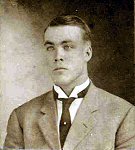
1. Dolan Wilson.
|

2. "Jack" Wilson.
|
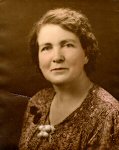
3. Cora Lee (Wilson) Mancill.
|

4. Minnie Geneva Wilson.
|
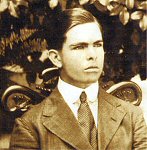
5. Bosso Wilson.
|

6. Hattie Mae Wilson.
|

7. Annie "Gussie" Augusta (Wilson) Burnett.
|

8. Jay Tee (Wilson) Franklin.
|
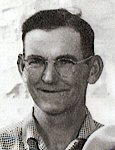
9. John T. Jr. Wilson
|
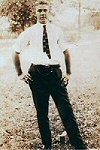
10. B.B. Wilson.
|
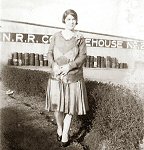
11. Ella Wilson
|
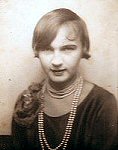
12. Kate Wilson.
|

16. Marjorie Etheline Wilson.
|
Grandpa was named after the Alabama governor, Braxton Bragg Comer, elected in 1907 and served through 1911. Grandpa's family and friends called him "B.B." or as my Dad called him "B". There was also a Confederate Civil War General named Braxton Bragg who this governor was named after. General Bragg had a brother named John Bragg who built the Bragg-Mitchell Mansion in downtown Mobile in the late 1800's.
Grandpa was only eight years old when his father, John T. died from peritonitis caused by a ruptured appendix. Grandpa never talked much about his growing up years or we just never knew to ask him. Apparently he did the usual boy things because I found a newspaper column where Grandpa went to a basketball game in Bay Minette with a friend. And just think how long it took them to get to Bay Minette from Blacksher by dirt roads and horse and buggy; it takes a good thirty minutes today going sixty miles an hour in a fast car! By the time he was nineteen years old his mother and younger sisters had moved from Blacksher to Silverhill.
|
His education consisted of years spent at the Daphne Normal School in Daphne, Alabama. The children would room with a family in the Daphne area for the week and go home on the week-ends. He graduated from the seventh grade and I don't believe he had any further education. He was extremely good with numbers, could build anything with lumber, could grow crops, but more than anything, he could and loved to fish! He came from a family that loved to fish which was one reason they were drawn to this area, with it's abundance of creeks and rivers. Growing up I can always remember on Thanksgiving or Christmas morning, him coming home from fishing in that ole black truck pulling that ole green boat behind it and he never failed to pull out a string of speckled trout.
|
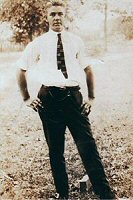
|
|
Braxton Bragg Comer Wilson circa 1921, Graduation Daphne Normal School. - Click to enlarge.
|
 He was twenty-one years old when he met and married a young lady, named Jennie Barbara Philips on May 26, 1928. I have a copy of their marriage record from the Bay Minette Courthouse. They evidently enjoyed going to the beach at Gulf Shores because Grandma had two collections of sea shells she treasured all her life. One set of three large shells is in the possession of a grandson and she told him she collected them in 1923. Another set she told me she collected on a trip to the beach with Grandpa and she kept them up in her closet till the day she died.
He was twenty-one years old when he met and married a young lady, named Jennie Barbara Philips on May 26, 1928. I have a copy of their marriage record from the Bay Minette Courthouse. They evidently enjoyed going to the beach at Gulf Shores because Grandma had two collections of sea shells she treasured all her life. One set of three large shells is in the possession of a grandson and she told him she collected them in 1923. Another set she told me she collected on a trip to the beach with Grandpa and she kept them up in her closet till the day she died.
They continued to like to go to the beach. On holidays like July 4th and Memorial Day, Grandpa would go down to the Gulf State Park early and stake us out a good spot with a picnic table or two or three. The rest of us would go on down a little later and have a fun-filled day swimming, grilling, eating watermelons and all the other holiday goodies.
Jennie Barbara Philips was born on August 13, 1904 to parents, Mike and Barbara Kula Philips in Potter County, South Dakota. Mike Philips was born in 1850 in Servia, Bohemia and died April 10, 1946 in Silverhill, Alabama and is buried in the Silverhill Cemetery. Barbara Kula Philips was born in 1871 in Wisconsin and died on April 19, 1955 in Silverhill, Alabama and is buried beside her husband in the Silverhill Cemetery.
There were six siblings in the Philips family:
-
Anna May (Philips) Zuber, born July 10, 1893 and died Nov. 1957;
-
Emma C. (Philips) Myers, born 1895 and died Nov. 2, 1975;
-
Frank David Philips, born May 26, 1896 and died Dec. 1984;
-
John Lee Philips, born July 29, 1898 and died Jan. 3, 1972;
-
Albert Mike Philips, born Nov. 15, 1901 and died Nov. 2, 1999;
-
Jennie Barbara (Philips) Wilson, born on Aug. 13, 1904 and died in Feb. 14, 2001.
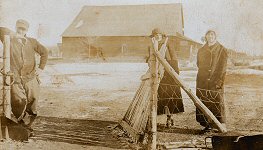
Philips' Family Farm in South Dakota about 1900.
|
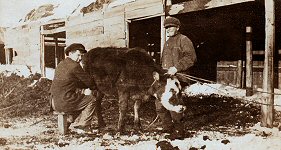
Philips' Family Farm in South Dakota about 1910.
|
When the Philips Family first came to the United States through Ellis Island in New York and homesteaded in South Dakota, they lived in a sod house in the side of a hill, which was the custom in that area. Remember, no pine trees or really, no trees much at all. Mike Philips was sixteen years old when he first made the trip over by passenger ship in 1866; unfortunately these records from Ellis Island were all destroyed in a fire. He would make one more trip back to his homeland of Bohemia to bring additional family members back to the United States.
The Philips family along with a group of countrymen living in the Bohemian community in Potter County, South Dakota saw brochures advertising Silverhill, Alabama and traveled down in circa 1918 to investigate the area. Apparently they liked what they saw and the men and boys moved down to build homes, barns, and prepare the land for farming. An additional benefit and drawing factor to this area was the fact that Barbara Philips had very bad arthritis and the doctor told her this southern climate would be beneficial for her health. Unfortunately, it did not help her health. The men traveled back to South Dakota in 1922 and moved the women and children south.
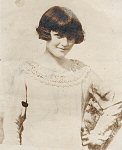
Jennie Barbara Philips circa 1920.
|
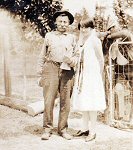
Mike Philips, daughter Jennie, and son, Frank in background circa 1923 in Silverhill.
|
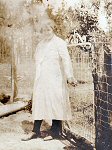
Barbara (Kula) Philips circa 1923 in Silverhill.
|
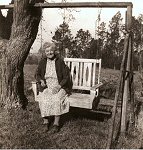
Barbara (Kula) Philips in Silverhill circa 1948.
|
Jennie Philips was eighteen years old when she rode the train south to Robertsdale, Alabama. Her parents built a home at the end of First Street in Silverhill and their great-grandchildren continue to live in it today. Philips is also spelled Fhilips. The Philips family spoke Bohemian and my father remembers that on Sunday afternoons the family would usually gather at Uncle John Philips home on East Boulevard and my father could not understand a word that was spoken; he said they sounded like a bunch of magpies, "what a racket". Grandma tried to teach us the language but we never did learn to speak it fluently.
Grandma and her older brothers, John and Albert chose to stay in Silverhill but Frank, Emma and Annie went back to South Dakota to live. The three older children were already pretty much independent. Frank never married and made frequent trips to Silverhill to visit with family. Grandma stayed due to her mother's health.
 When Grandma was a teen-ager she loved to go to the Little Hall (Bohemian Hall) for dances. This was a weekly event and the whole Czech community would attend. The children would fall asleep under the benches that lined the walls while their parents and older siblings had fun late into the evening. Grandma had a dance card holder with a little gold pen attached by a gold chain that she kept forever; it is in possession of a grandson at present.
When Grandma was a teen-ager she loved to go to the Little Hall (Bohemian Hall) for dances. This was a weekly event and the whole Czech community would attend. The children would fall asleep under the benches that lined the walls while their parents and older siblings had fun late into the evening. Grandma had a dance card holder with a little gold pen attached by a gold chain that she kept forever; it is in possession of a grandson at present.
The teens in that era, as today, enjoyed attending the local community fairs. I have a wonderful picture of Grandma and her friend, Francis Sturma, at the Bay Minette Fair, standing beside an old Model-T car in long coats of the time with some little clown dolls they had won at the fair. She also saved a little ruby-red glass pot with a wire handle with her name and the year 1915 written on it that she bought at a fair in South Dakota when she was just a child of eleven years.
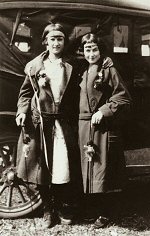
Francis Sturma and Jennie Philips at Bay Minette Fair in 1926.
|
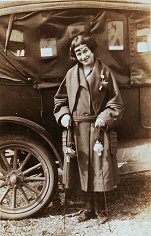
Jennie Philips at Bay Minette Fair in 1926, age 22 years old.
|
So, Grandpa and Grandma married and purchased land from his mother, Annie Wilson, "For one dollar and with love and affection". It was located on present day Camellia Road east of Highway 55. It remains in the Wilson family today. They built a house there that remains, although it has been renovated. As the years passed, Grandpa built a barn for the cows, horses, mules, and pigs. There was also a corn crib for the corn to be stored in to feed the animals through the winter. He built a garage for his truck and one for his boat. These were blown down, one by one, by hurricanes, beginning with Camille in 1969 and ending with Katrina in 2005. Grandma had her "wash house", her "fruit house" and her "garden shed". Earlier in the 1930-1940's Grandma had rows of chicken houses where she raised hundreds if not thousands of chickens. She sold the eggs to the Silverhill Farmers Association who sent a truck around to collect the eggs every two days. I can remember the egg house with the scales and other items necessary for processing the eggs for market.
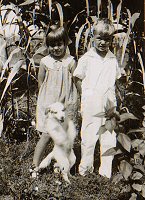 Grandma told me the story of how the "Traveling Peddler" came up the road one day and hanging on the side of his wagon were two little Windsor chairs for children. She said she just had to have those little chairs for Alton and Eloise, so she bartered eggs and bought the chairs. We still have them today.
Grandma told me the story of how the "Traveling Peddler" came up the road one day and hanging on the side of his wagon were two little Windsor chairs for children. She said she just had to have those little chairs for Alton and Eloise, so she bartered eggs and bought the chairs. We still have them today.
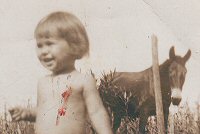 Then they had a mule, named Jenny, and Ted Forsman would come up the road in a horse and buggy, calling "Jenny". Was he calling Jenny or Jennie? He laughs as he tells the story. There is a picture of Eloise as a toddler standing in front of the mule, Jenny.
Then they had a mule, named Jenny, and Ted Forsman would come up the road in a horse and buggy, calling "Jenny". Was he calling Jenny or Jennie? He laughs as he tells the story. There is a picture of Eloise as a toddler standing in front of the mule, Jenny.
When Grandpa and Grandma first married times were hard. It was the beginning of the Great Depression and money was hard to come by. Grandpa worked for the Silverhill Creamery in Silverhill and later for the sawmill in Robertsdale before he went to work for the State of Alabama Highway Department from which he retired after thirty years of service with the certification of Heavy Equipment Master Mechanic. He walked three miles to the Robertsdale sawmill every day to be paid a dollar a day for a full eight hours of work. Hard to believe in today's world. The home they built for $500.00 had to be rented out for a year because they could not make the mortgage payment of nine dollars a month. During that period they lived in a room built behind his mother's pump house.
The Mancill cousin's remember during the hard-times of the Depression and the Recovery afterwards, Grandpa would bring them boxes of food, supplies and firewood. Their mother was the oldest sister, Cora Lee. Her husband, Elliott Mancill, farmed and preached but that brought in little cash money with which to buy supplies for a family of ten. Her sons remember her crying when Grandpa would come bearing gifts. Grandpa was a caring, kind man who always reached out to people. Most people never saw him dressed up; one would usually just see him in those gray "Dickie" work clothes. Most pictures show him dressed that way.
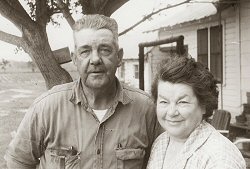 Grandpa's favorite saying was "That's all she wrote". Daddy was with Grandpa when he went to the doctor in Foley and found out he had lung cancer. Daddy said "Grandpa was devastated". He threw the cigarettes out of the truck window on the way home and said, "That's all she wrote". He died on June 29, 1972 and is buried in the Silverhill Cemetery. What a loss to his family and his soul mate who would go on to live another twenty-nine years without him.
Grandpa's favorite saying was "That's all she wrote". Daddy was with Grandpa when he went to the doctor in Foley and found out he had lung cancer. Daddy said "Grandpa was devastated". He threw the cigarettes out of the truck window on the way home and said, "That's all she wrote". He died on June 29, 1972 and is buried in the Silverhill Cemetery. What a loss to his family and his soul mate who would go on to live another twenty-nine years without him.
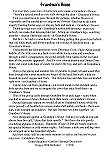 Now, Grandma's house; "Oh, the memories made in it over its lifetime". In the beginning the house consisted of four rooms, with a front and back porch. Later additions would be built by Grandpa and the Mancill boys. See a poem called "Grandma's House". Grandma loved her flower and vegetable gardens up until the time she had to go into a nursing home where she spent the last seven months of her life.
Now, Grandma's house; "Oh, the memories made in it over its lifetime". In the beginning the house consisted of four rooms, with a front and back porch. Later additions would be built by Grandpa and the Mancill boys. See a poem called "Grandma's House". Grandma loved her flower and vegetable gardens up until the time she had to go into a nursing home where she spent the last seven months of her life.
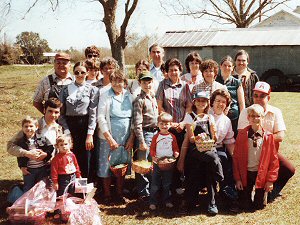 Even there she would want to go sit in the courtyard and pull weeds out of the flower beds. Through the years she sewed clothes for her children and grandchildren; sheets, towels, curtains, and anything else that needed sewing on an old Singer treadle sewing machine. I can remember going with her to pick out pretty feed sacks that were made out of all kinds of different patterns and colors at Clark's Feed Store and across the road in the Sopr's big barn. She also quilted some beautiful quilts.
Even there she would want to go sit in the courtyard and pull weeds out of the flower beds. Through the years she sewed clothes for her children and grandchildren; sheets, towels, curtains, and anything else that needed sewing on an old Singer treadle sewing machine. I can remember going with her to pick out pretty feed sacks that were made out of all kinds of different patterns and colors at Clark's Feed Store and across the road in the Sopr's big barn. She also quilted some beautiful quilts.

Jennie's Crocheted Doily.
Click to Enlarge.
|
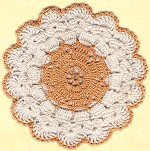
Jennie's Crocheted Doily.
Click to Enlarge.
|
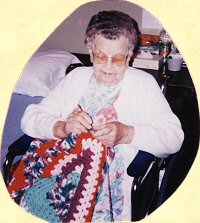 Her favorite past-time was crocheting. She had a favorite pattern for afghans and booties. She made and gave away hundreds of them in all sorts of colors, patterns, and sizes. Her hands were never still. Even into her nineties she could be found outside in her gardens in the heat of the summer or cold of the winter. She thrived on getting her hands in the dirt. She loved to share her flowers and vegetables with family and friends. When she finally had to "retire" it broke everyone's heart. But, Grandma never gave up. She went to physical therapy in the nursing home and continued to crochet until the day she went to join her "Valentine" in heaven, on February 14, 2001. She is buried next to Grandpa in the Silverhill Cemetery.
Her favorite past-time was crocheting. She had a favorite pattern for afghans and booties. She made and gave away hundreds of them in all sorts of colors, patterns, and sizes. Her hands were never still. Even into her nineties she could be found outside in her gardens in the heat of the summer or cold of the winter. She thrived on getting her hands in the dirt. She loved to share her flowers and vegetables with family and friends. When she finally had to "retire" it broke everyone's heart. But, Grandma never gave up. She went to physical therapy in the nursing home and continued to crochet until the day she went to join her "Valentine" in heaven, on February 14, 2001. She is buried next to Grandpa in the Silverhill Cemetery.
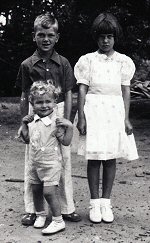 B.B. and Jennie had three children. Alton Comer, born Dec. 26, 1928 and died Nov. 18, 1988; Eloise Barbara, born April 2, 1930 and Willard Leon, born May 13, 1936. Both sons served in the military and their respective churches. Eloise has been a devoted wife, mother, grandmother and now, great-grandmother. At the time of her death, Jennie had ten grandchildren, sixteen great-grandchildren and two great-great-granddaughters. The family continues to grow.
B.B. and Jennie had three children. Alton Comer, born Dec. 26, 1928 and died Nov. 18, 1988; Eloise Barbara, born April 2, 1930 and Willard Leon, born May 13, 1936. Both sons served in the military and their respective churches. Eloise has been a devoted wife, mother, grandmother and now, great-grandmother. At the time of her death, Jennie had ten grandchildren, sixteen great-grandchildren and two great-great-granddaughters. The family continues to grow.
Grandpa and Grandma worked hard, taught their family the real values of life, loved their family and provided well for them. So much could be said, so many memories of good times and days gone by. So many loved ones gone on, but the lessons about life and family, together with the love woven throughout, will live in our hearts and minds forever.

This Family History was contributed August/September 2007 by
Carolyn Hastings Dickinson.
Carolyn can be contacted at
21960 Second Street,
Silverhill, AL 36576
251-945-5307
and meemee@gulftel.com
Edited by Debbie Owen

|